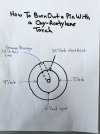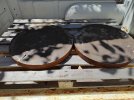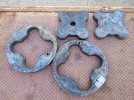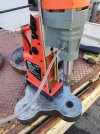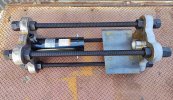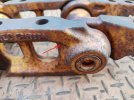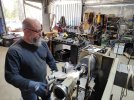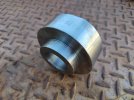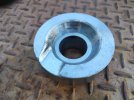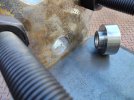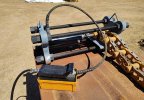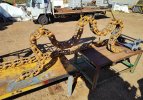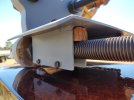I bought a pile of near-new Berco Cat D4 size track chains recently from a port that had some handling experiment going on.
They purchased a pile of these chains, they barely used some and seem to have never used most of them.
Then then set them in a storage yard for about 5 years, then they sold them as scrap. So I fought off a few other interested buyer and won them.
But the link numbers are all over the place, most seem to have 44 links and a couple have 30 links.
I sold 2 sets of chains to 2 different buyers who own old D4C's and they need new tracks, so I need to adjust the track chains to 36 links for these guys.
The last time I set foot in a track shop, they essentially wanted a AU$1000 just to even press out one pin.
The local track shops get spoilt beyond belief with mining companies giving them $100,000 track jobs every day.
I got a quote on turning pins and bushings in a set of D7 a couple of years ago and the track shop quoted AU$11,000 for the job!! What a joke!
Essentially, they indicated they couldn't even be bothered with a D7 pin and bushing turn, seeing as they do several D11 tracks and mining shovel tracks, every week.
With all this in mind, I set out to build my own little portable track press - at low cost.
I knew a salvage guy who had some 50 ton press cylinders for sale, so I went and bought one off him for AU$400.
This cylinder is made in Taiwan and seems pretty well made. It has a 10" (250mm) stroke, so that was what I was mostly interested in.
The cylinder is secured to the base plate by 2 x 12mm HT bolts, there were 2 convenient threaded holes in the base of the cylinder.
I acquired the following to complete the job - some 5mm plate offcuts, 2 x 500mm (18") diameter x 50mm (2") thick pieces of scrap plate, 4 x 36mm high-tensile (grade 8.8) x 1 metre long, threaded rod, and a full box (25) of 36mm nuts.
The 5mm scrap was $1 a kg, the 50mm plate offcuts were high-tensile Bisalloy and cost me $20 for the 2 pieces.
The 4 x threaded rods cost me AU$180, and the box of nuts was AU$65.
I worked out a simple press plates design, and made a cardboard template of the shape I wanted.
I got the 50mm plate plasma cut by a local metal-fabrication company. It took me a while, either no-one wanted to cut it, or they wanted multiple hundreds of dollars to cut it.
The company that ending up cutting the plate, did it for AU$100. Too easy. I even got the remnants back off them.
The plasma cutters did a pretty neat job, accurate to within about 5mm and only needed a small amount of clean-up with the angle grinder.
I bought a Chinese mag drill (AU$250) and a 36mm Chinese carbide annular cutter (AU$36). I used the mag drill and annular cutter to do the 8 holes in the 2 plates that I needed.
Those annular cutters are great, took me about 15mins per hole, taking it easy. The drill even came with a coolant bottle, so I could keep coolant running on the cutter to ensure it kept sharp.
I had to trim the centre hole I had installed in one press plate with a die grinder and a carbide burr to get it to a more accurate shape.
Didn't need a machined finish, just needed it reasonably round, which I achieved with a final cleanup with a drum sander.
I made up a track chain support plate out of the 5mm scrap plate. I used two small blocks of hardwood to set it on, over the threaded rods.
The hardwood blocks protect the threads of the rods, and I can adjust the height of the support plate simply by cutting the blocks to size to match whatever variation of track link I'm working on.
I'm just setting this press up for small tractors, I don't need to work on big tractors any more, this is essentially a hobbyist/farmer/collector setup.
The threaded rods should be good for 100 tonnes, but I'm just using the 50 tonne cylinder at present. If I need to "upgrade", I can always go to a bigger tonnage cylinder, the frame is more than capable.
The final piece of fabrication involved machining up a support collar to support the link against the end plate.
Fortunately, stepdaughters partner just bought himself a nice little Taiwanese lathe, and he kindly offered to machine up the collar.
I cut a piece out of the 50mm scrap plate remnants and he went to town on it with the lathe and made the collar to my template and plans.
The final part was to install a cut-out in the collar to accommodate a reinforcing rib on the link that stopped the collar from giving its full support to the tapered face of the pin boss (see arrow on link photo).
I made this cut-out with the die grinder and a 1/2" carbide burr, and it worked just fine for fit.
Lastly, I cut a couple of pieces of 12mm bar about 185mm long, bent them to about 80° in my portable 20 tonne, 250 mmm (10") wide plate/bar bender, and welded them on to the 500mm plates for lifting eyes.
Yesterday, I went out to my block in the country where the tracks are stored, set up two old benches to hold the chains and the press, lifted the chains into place with my tractor crane - and I'm pleased to report my little press works a treat!
I got 3 pins pressed out before my little Honda-powered air-compressor quit for an unknown reason, possibly a faulty spark plug.
I ran out of time to fix it, I'll get back onto the track chain shortening/lengthening project later in the month. Suffice to say, I've got a track press that works great, it cost me less than AU$1000 all up.
I already had the little Chinese foot-operated press pump, I probably need to upgrade to a large pump unit, as the 1.6 litre capacity of the little foot pump is barely enough for the full stroke of the press cylinder.
I have a spare electric pump with a bigger capacity, I just need to set it up, as it was originally designed to hold off spring-loaded disc brakes on industrial equipment such as conveyors.

